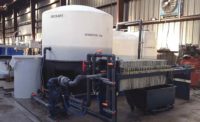Water filtration and clarification systems have become so critically important for fabricators like never before. OSHA regulations and monitoring of sludge has increased exponentially over the last several years to keep the sludge out of the water drains. But what has really brought on a bigger need for closed-loop water recycling systems — additional water is not needed; all of the water is reused without needing fresh water, minus normal evaporation — is the automation that has become so prevalent in almost every fabrication shop now. Specifically, automated inline machines. These machines use a minimum of 15 gpm going all the way up to 45 gpm. Some shops will have multiple of these machines. Bridge saws use about 12 gpm. CNC machines use between 12 to 20 gpm. Each hand polisher will use about 3 gpm. So it’s not very difficult for a small to average shop to consume 60 to 100 gpm. Larger shops will double or triple that. From a cost perspective, if a shop is spending at least $400 or more per month on water, the Return on Investment (ROI) on a closed-loop water filtration system is very short — less than five years. Then, they will have free water for 20+ years. It keeps OSHA away and really does help our environment.
There are two basic types of closed-loop water filtration systems found in the stone industry. Filter press systems and the traditional silo-style gravity decanter systems. Filter press systems use a high-pressure press system created inside the filtering chambers through special pumps that filter the water. The water then goes to a clean water holding tank for use back through the shop.
The traditional tried-and-true gravity silo decanter system works by pumping the water into the silo, mixed with flocculant chemical and allowing the water to separate. The sludge sinks to the bottom and clean water stays on top and then flows to clean water holding tanks for reuse back to the machines.
Both systems produce excellent water for general shop use. Micron filters can be added for crystal clear water for use for the CNC spindle and any/all other water applications. Both systems can be built for any size water consumption needed. Both systems are tailored/built for each specific fabricator based on building layout, machines, water consumption and future growth.
What are the pros and cons of each? That’s in the eye of the beholder and preference. Do both types of systems work? Absolutely. Do both systems offer gray and crystal clear water? Absolutely. Do both systems offer full closed-loop systems and drastically reduce/eliminate water bills? Absolutely. Do both systems manage sludge? Yes, both can offer filter press cakes. To save money, the silo decanter system offers a bag option. Do both recommend water storage tanks for flow back to the machines? Yes. Do both systems differ in how they clean the water? Yes, they do differ in the process. But in the end the water is clear and can be used throughout the shop in all machines. Both have pit pumps that suck all the sludge from the pit (never hand clean the pit again). Both systems use pumps to send the water from the water storage tanks back to the machines. Both systems can be installed in about one day.
Are there differences in price? Budgets are important and each shop will determine what they can spend based on the amount of water usage. I would highly recommend not particularly starting a conversation with price, but on exactly what your shop needs are now and in five years from now — or however far you can forecast. Then, the manufacturers can tell you what you need and then things can be tweaked/adjusted. It would be a shame to say that you are spending “X” amount of dollars when the ideal system is only $4,000 more. I promise you, two to five years from now, you will never remember the $4,000 difference, but you will remember each and every day in your shop whether you have enough clean water.
Also, keep in mind that almost all of these systems can be expanded in the future as well. It will come at a higher cost, but if budget doesn’t allow now for your future growth, plan on floor space and layout for the expansion at a later time.
Dust collection
Dust collection has now become not just needed, but absolutely critical for each and every stone shop. OSHA has lowered the silica standard for very good reasons. Silica needs to be taken very, very seriously. It will literally kill you.
There are two types of dust collectors: wet and dry systems.
Wet systems, known as water walls, are the traditional waterfall systems where you fill the basin with water and a pump circulates the water and makes a waterfall. Air/dust is then sucked through the water, and once the dust touches the water, it gets trapped and sinks down into the basin. Because the air must be sucked through water and loses force, the water wall systems are less efficient than the dry systems, with an average dust collection of about 90% of dust. This is still excellent and works.
Dry systems do not use water at all. Inside the dust collector are special filters designed to capture the dust particles found in fabrication shops. The air/dust is sucked into the unit and the dust is trapped by the filters. The Filter Project’s 13-foot automatic dry system, for instance, has 72 filters inside that capture 99.9% of the dust that passes through it. Each time the dust collector is turned off, it goes through an automatic self-cleaning cycle that releases all the dust from the bags and captures it in dust collection trays at the bottom of the unit. When the trays are full, simply empty the trays.
Due to the efficiency of both wet and dry systems, the air coming out of the exhaust does not need to be vented outside. For low ceiling heights, it is recommended to duct the air flow away from the front of the unit for proper directional air flow.
Wet and dry dust collectors range in size from 6 to 17 feet, with the most popular sizes being 10 and 13 feet.








